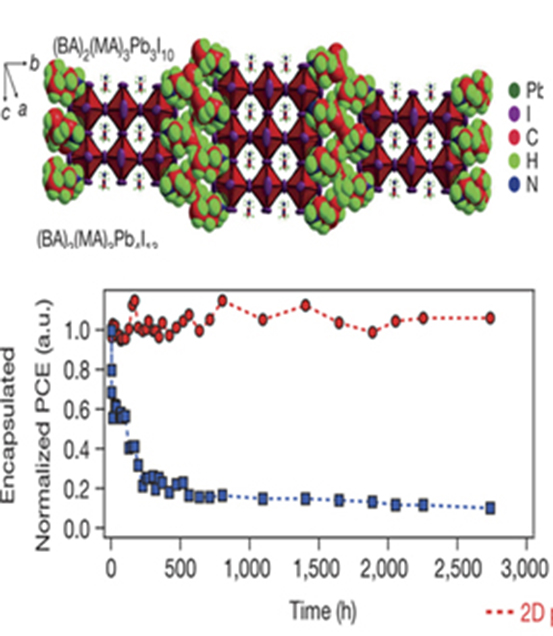The Tricky Trifecta of Solar Cells
The quest for solar cell materials that are inexpensive, stable, and efficient leads to a breakthrough in thin film organic-inorganic perovskites.

The Science
Layering thin sheets of two-dimensional (2-D) perovskite materials creates a promisingly stable solar cell. However, the cell is not as efficient as its thicker, less stable three-dimensional (3-D) counterpart. Scientists overcame the inefficiency of 2-D perovskite solar cells without sacrificing stability. They did so by redesigning the cell so that the perovskite sheets were preferentially oriented perpendicular to the substrate, like books on a bookshelf.
The Impact
These new materials may enable the “trifecta” of solar cell properties: inexpensive, stable and efficient. They are inexpensive because they are solution synthesized. They are stable on technologically relevant time scales. They are efficient with as high as 12.5 percent power conversion efficiency.
Summary
Three-dimensional (3-D) organic–inorganic perovskites have emerged as one of the most promising thin-film solar cell materials owing to a dramatic increase in their efficiencies in just a few short years, combined with their compatibility with inexpensive synthesis methods. A major challenge, however, has been a property just as critical: environmental and photo stability under operating conditions. As one possible solution, scientists have been studying Ruddlesden-Popper phases: layered two-dimensional (2-D) counterparts to the 3-D perovskites. These 2-D perovskite films have previously shown promising stability, but relatively poor photovoltaic efficiency (4.73 percent). The scientists attribute the low efficiency to inhibition of out-of-plane charge transport by organic cations, which act like insulating spacing layers between conducting inorganic slabs. A research team overcame this poor efficiency by synthesizing thin films of near-single-crystalline quality, in which the crystallographic planes of the inorganic perovskite component are preferentially out-of-plane aligned with respect to the electrical contacts, thus facilitating charge transport. Photovoltaics based on these 2-D perovskite films exhibit an efficiency of 12.52 percent and, when encapsulated, do not degrade under constant simulated solar illumination and humidity for weeks.
Contact
Mercouri G. Kanatzidis
Department of Chemistry, Northwestern University, Evanston, IL 60208
m-kanatzidis@northwestern.edu
Aditya D. Mohite
Los Alamos National Laboratory, Los Alamos, NM 87545
amohite@lanl.gov
Funding
The work at Los Alamos National Laboratory (LANL) was supported by the LANL Laboratory Directed Research and Development Program. It was partially performed at the Center for Nonlinear Studies and at the Center for Integrated Nanotechnologies, a U.S. Department of Energy (DOE) Office of Science user facility. Research at Northwestern University was supported by the DOE Office of Science. Use of the Advanced Photon Source, a DOE Office of Science user facility, at Argonne National Laboratory was supported by the DOE Office of Science. The research also used resources of the Center for Functional Nanomaterials, which is a DOE Office of Science user facility at Brookhaven National Laboratory. Work at INSA de Rennes was performed using high-performance computational resources from the French national centers: Cellule Energie du CNRS, the University of Rennes, and the Fondation d’entreprises banque Populaire de l’Ouest. The work at Purdue University was supported by the Bay Area PV Consortium, a partnership funded by DOE. Research at Rice was supported by the National Science Foundation Division of Materials Research.
Publications
H. Tsai, N. Wanyi, J.C. Blanson, C.C. Stoumpos, R. Asadpour, B. Harutyunyan, A.J. Neukirch, R. Verduzco, J.J. Crochet, S. Tretiak, L. Pedesseau, J. Even, M.A. Alam, G. Gupta, J. Lou, P.M. Ajayan, M.J. Bedzyk, M.G. Kanatzidis, and A.D. Mohite, “High-efficiency two-dimensional Ruddlesden-Popper perovskite solar cells.” Nature 536, 312-317 (2016). [DOI: 10.1038/nature18306]
J.C. Blancon, H. Tsai, W. Nie, C.C. Stoumpos, L. Pedesseau, C. Katan, M. Kepenekian, C.M.M. Soe, K. Appavoo, M.Y. Sfeir, S. Tretiak, P.M. Ajayan, M.G. Kanatzidis, J. Even, J.J. Crochet, and A.D. Mohite, “Extremely efficient internal exciton dissociation through edge states in layered 2D perovskites.” Science 355, 1288-1292 (2017). [DOI: 10.1126/science.aal4211]
Highlight Categories
Performer: University , DOE Laboratory , SC User Facilities , BES User Facilities , APS , CFN , CINT
Additional: Collaborations , EERE , Non-DOE Interagency Collaboration , International Collaboration



